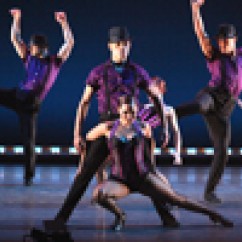There is nothing more exhilarating in the Chicago dance community than Dance For Life, stronger than ever in its 24th annual concert fundraiser for The AIDS Foundation of Chicago and The Dancer’s Fund.
The benefit for both the recipients of assistance and for the artists and producers who donate their time and talent to the project was palpable both on stage and in the audience at the Auditorium Theatre last Saturday night in what has come to be an annual pep rally for Chicago Dance.
Sustained now for nearly a quarter century, Dance For Life has created a unique means for bringing Chicago dancers, choreographers, and company directors together in a process that enriches the creative, mutually supportive environment that has come to characterize Chicago’s dance community.
This year, seven diverse dance companies and independent dancers joined forces to present a grand slam performance. Each of the superb pieces presented seemed to sparkle with an extra measure of passion for the gift of dance to heal and to inspire.
New this year, in a brilliant stroke of programming savvy, was the collaboration of The Second City’s Joey Bland and Tim Mason as Emcees who peppered the evening with humor, both live and on video. In a running gag of video segments between numbers throughout the evening, Hubbard Street’s Glenn Edgerton, in a deadpan take on a lethal James Bond villain, charged the two with “making Chicago Dance proud.” Their efforts to enter the world of dance were funny and fun, but also gave dancers from all over town a chance to talk about Dance For Life and what dancing for life is all about.
The frothy exuberance of The Joffrey Ballet in Gerald Arpino’s “Viva Vivaldi” (1965) started the evening off with a bang, reminding us of the early Joffrey company’s then-innovative mix of the classical with modern. Arpino’s take on the courtly manners of Vivaldi’s Baroque era created a showcase for the Joffrey’s technical brilliance. The breezy choreography combined Graham-esque low runs and spiral straight-arm swings with finger-clicking, knee-slapping court dances, every note accounted for in spot-on emboitees, brisees, and tours a la seconde.
Hubbard Street Dance Chicago gave us both the sublime and the ridiculous with two renderings from recent repertoire. Alejandro Cerrudo’s “Second To Last” (2013) is a silken poem to intimacy for five couples. Set to music by Arvo Part, this lyrical suite of duets featured arms like wings and seamless lifts forward, backward, and to the side, propelled by the women’s legs running on thin air and into flight.
Physical humor took the stage as ardor met the height of passivity in Robyn Mineko Williams’ “Wicked At Heart,” an excerpt from “The Art Of Falling” (2014), HSDC’s fruitful collaboration with The Second City. Hubbard Street’s Jason Horton’s frustrated lover brought the house down trying to woo Alicia Delgadillo’s mercilessly inflexible inflatable babe.
The Chicago Human Rhythm Project’s reprise of it’s acapella tap composition by Lane Alexander and Bril Barrett introduced a complete change of pace with the feel of raw street stomping and the brilliance of body music in complex rhythms created by the eight tappers.
Giordano Dance Chicago left the audience feelin’ very good indeed with an electrified delivery of Ray Leeper’s “Feelin’ Good Sweet” (2014). With plenty of sass, sexy moves, and hats tipped to slick commercial dance conventions, the piece transcends its genre with smart spatial design, tour de force ensemble sequences, and choreography that rips up the stage with go-for-broke dancing. Giordano dancers never looked better setting the Auditorium stage on fire.
 "Feelin' Good Sweet"
"Feelin' Good Sweet"
Unusual props added interest to Act II with C5’s “Garland Suite,” in a smooth ballroom dance-inspired scene combining Judy Garland’s sultry version of “Get Happy” and jazzy trapeze art on giant swings. Same Planet, Different World used rows of long wooden benches to take advantage of multiple levels in “To Have and To Hold.” A combination of unison group action and cannon created a mesmerizing visual effect with the six white-clad dancers tumbling over and under one another, rolling on and off the benches, diving across to each other, embracing and recombining.
River North’s excerpt from Frank Chaves’ poignant “In The End” for six men was both heart wrenching and uplifting in its stunning exploration of masculinity. Chaves’ movement invention is at once bold and vulnerable, beginning with the human chain of linked arms that support, restrain, and unite the six dancers. Clad only in the briefest of briefs, their bodies gave testimony to the nuanced beauty of their movement.
Randy Duncan’s iconic “Stand By Me” delivered a powerhouse finale to a spectacular evening, uniting a total of seventeen dancers, eleven from nine different companies and six independent dancers, all cast through an audition process. Their polish and dancing chops equaled their enthusiasm in a performance that dazzled with Duncan’s choreographic plea for solidarity and community. Exactly what this wonderful annual effort continues to inspire.

